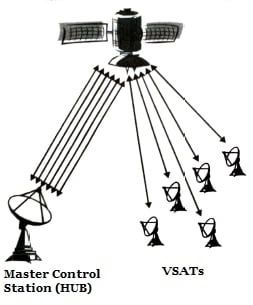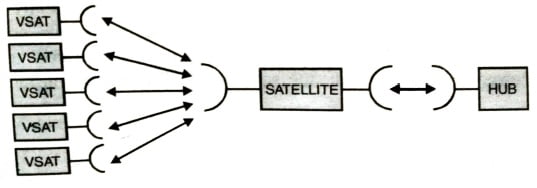Table of Contents
Very Small Aperture Terminal (VSAT)
VSAT stands for Very Small Aperture Terminal. In satellite communication, the development and technology have allowed, data and voice communication cost-effective for a broader range of users. In VSAT the earth station size is typically less than 2.4 m in diameter. The trend is toward even smaller dishes not more than 1.5 m in diameter.
Very Small Aperture Terminal (VSAT) Structure
The basic structure of a VSAT network is shown in the figure below. A VSAT consists of two parts, a transceiver that is placed outdoors in direct line of sight to the satellite and a device that is placed indoors to interface the transceiver with the end communications device, such as a PC. The transceiver receives or sends a signal to a satellite transponder in the sky. The satellite sends and receives signals from a ground station computer that acts as a huh for the system.

Each end user is interconnected with the hub station via the satellite, forming a star topology. The hub controls the entire operation of the network. For one end user to communicate with another, each transmission has to first go to the hub station that then retransmits it via the satellite to the other end user’s VSAT.
It consists of a hub station which provides a broadcast facility to all the VSATs in the network and the VSATs themselves which access the satellite in some form of multiple access mode.
The hub station is operated by the service provider and it may be shared among a number of users. Time-division multiplex (TDM) is the downlink mode of transmission from hub to VSAT, and the transmission can be broadcast for reception by all the VSATs in a network, or address coding can be used to direct messages to selected VSATs.
VSAT Network Architecture
VSAT systems can be implemented in three basic architectures,
- One-way implementation.
- Split-two-way implementation.
- Two way implementation.
One-Way Implementation
This is the mode of a satellite used in the Broadcast Satellite Service (BSS). The introduction of digital telephony allows the provider and user much greater flexibility in the operation of a broadcast network. The figure below shows the schematic of a BSS.

Split-Two-Way Implementation
This implementation is used when there is no normal return channel (E.g., with Ku band broadcast satellite service systems that carry Internet traffic). The relatively high capacity downlink stream is not complemented by an uplink capability from the user terminal. If the BSS downlink is used as the download channel from an internet service provider, the only option the user has for a return link is via another telecommunications channel, such as a standard telephone line. The Internet Protocol (IP) is therefore split between a satellite downlink (outbound) channel and a terrestrial telephone (inbound) channel: hence the term split IP for this implementation.
The advantage of this approach is that the VSAT terminal does not require a transmit capability, which significantly reduces its cost and complexity.
The disadvantage is that the telephone line connection must ususlly be through a modem, with a bet rate gencrally restricted to 56 kbps.

Two Way Implementation
The service includes a return link so as to establish two-way communication over the same satellite, from the hub to the user and from the user back to the hub. Two topologies are implemented: Star topology and Mesh topology.
Star Topology
Here, all of the traffic is routed via the master control station, or hub. If a VSAT wishes to communicate with another VSAT, they have to go via the hub, thus necessitating a “double hop” link via the satellite. Since all of the traffic radiates at one time or another from the hub, this architecture is referred to as Star network.

Mesh Topology
Here, each of the VSATs has the capability to directly communicate with any the other VSATs. The network control and the duties of the hub is either handled by one of the VSATs or the master control station functions are shared among the VSATs. Since the traffic can go to or from any of the VSATs, this architecture referred to as Mesh network.

Specifications
Some typical specifications of VSAT are:
- Antenna size: 1.2 m to 3.5 m
- Antenna gain: 40 dB
- Power uplink: 0.5-5 W
- G/T: 20 dB/°K
Typical specifications of Hub stations are:
- Antenna size: 3.5-10 m
- Antenna gain: 58 dB
- Power uplink: 50-200 W
- G/T: 30 dB/’K
Most VSAT systems operate in the Ku band (12-14 GHz) because it is less congested although there are some C-band systems in existance. For fixed area coverage by the satellite beam, the system performance is essentially independent of the carrier frequency. For fixed area coverage, the beamwidth and hence the ratio λ/D is a constant. The satellite antenna gain is therefore constant and for a given high power amplifier output, the satellite EIRP remains constant.
Applications of Very Small Aperture Terminal (VSAT)
Typical Applications of VSAT are:
- Computer communication
- Reservation system
- Database enquiries
- Billing system
- File transfer
- Video conferencing
- Stock control and management
- Credit card verification
- Point of sale transaction
Advantages of VSAT
- Cost insensitive to distance.
- Easy for installation and maintenance.
- Flexibility.
- Upgradeable.
- Large number of VSAT networks can be integrated into the single network to provide cost effective expansion.
- Mean time between failure (MTBF) > 25,000 hours (3 years)
- Reliable service: 99.9% for data and 99.5% + for voice.
Disadvantages of VSAT
- High initial cost (hubs and basic elements must be placed before the services can be provided).
- Lack of adequate coverage in some parts of the world.
- Some service quantity limitations such as high signal delays (latency).
- Unavailability of direct links between various VSATs.
- Rain attenuation might affect the performance of VSAT communications under rainy conditions.

